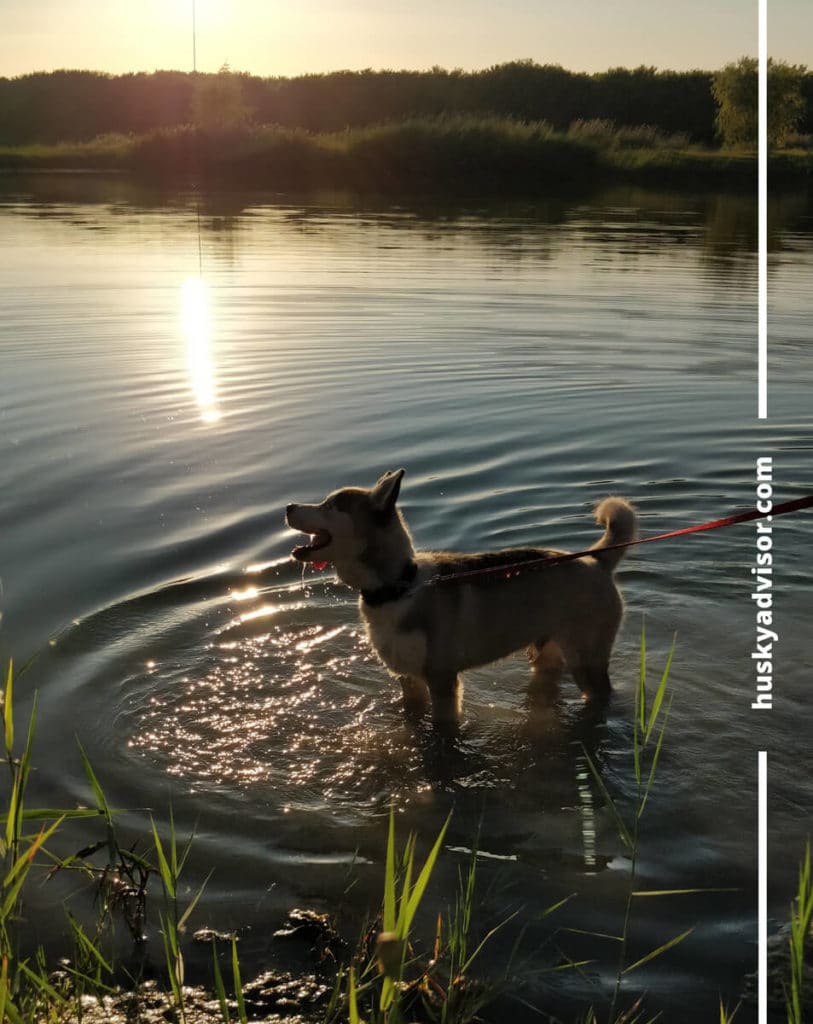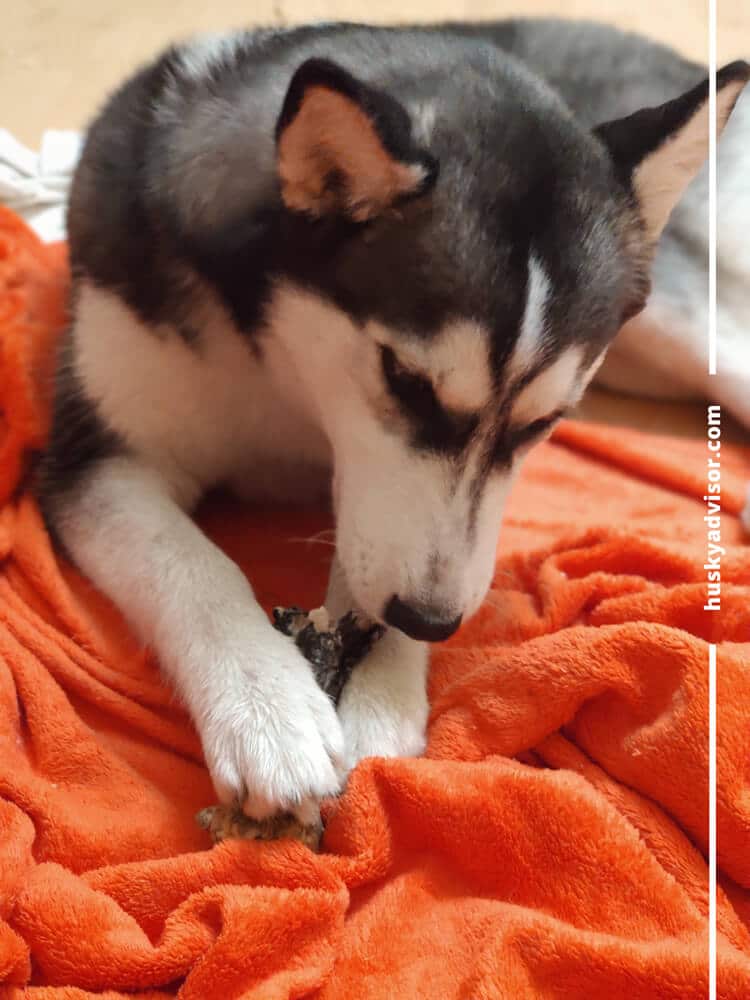Dogs can eat fish if the fish is properly prepared before feeding it to your dog. You must remove the bones before you give cooked fish to your dog. The healthy protein of the fish and the healthy omega-3 fatty acids will improve your dog’s general health. Properly cooked fish is a welcomed health boost for your dog’s body. You already saw wet dog food and dry kibble that contains fish. Also, fish treats for dogs are available everywhere nowadays. And dogs love the smell of them! But how can you cook fresh fish for your dog? We’ll discuss in this article more about how to feed fish to our dogs and what types of fish are good for dogs.
Do you want to add fish to your dog’s diet? Feed your dog only fish cooked in the oven, steamed fish, or grilled fish. Don’t add seasoning or oil when you’re cooking fish for your dog. Always remove the fish bones before you feed the fish to your dog. You can proportionate the fish by breaking the fish with a fork and refrigerate the portions. You can refrigerate the food containers for a maximum of three days. If you cook often for your dog, and you refrigerate or freeze the food, don’t forget to label de food containers. Write on the label the type of meat is in the food container and frozen date.
Can dogs eat raw fish?
I don’t give raw meat to my dogs, but this is the choice that I’ve made regarding my dogs’ diet. What do you need to know about raw fish? Raw fish can carry harmful bacteria such as listeria or salmonella, and it can even contain parasites such as roundworms, flukes, or tapeworms. Buy frozen fish and check the date when it was frozen or freeze the raw fish for a few weeks to eliminate the parasites before you give it to your dog. I still advise you to cook it properly and always remove the bones. You can always pick freeze-dried dog treats if you want to treat your husky with some fish.
Can dogs eat fish skin?
Dogs could eat fish skin if the fish didn’t come from polluted waters. The toxins found in water are stored in the fish’s skin and fat. Try to feed your dog fish skin from clean waters.
If the source of the fish is safe and the fish lived in clean waters, then you can prepare the fish skin for your dog. You can either give him a bit of skin from your cooked fish – make sure that it doesn’t have spices or oil on it and it’s completely cooked, or you can dehydrate the skin and feed your dog a bit from time to time. Don’t feed your dog the skin from an entire fish at once. That’s too much fish skin for your dog. There are plenty of dog treats made with fish skin online. Most dogs enjoy chewing and eating treats made with fish skin. Still, don’t overfeed your husky with treats. Keep your puppy on a balanced diet.
Can dogs eat fried fish?
Fish fried in oil is not good food for your dog. As it goes with all fried foods when it comes to giving them to your dog, the extra oil in which the food is fried is not adding nutritional value to your dog’s diet. Too much fried and greasy food can cause pancreatitis.
Can dogs eat fish bones?
Dogs can’t eat fish bones. Fishbones are dangerous because they are small and can get stuck in your dog’s stomach, throat or mouth. These thin and small bones can be very dangerous and cause harm to your dog. Always double-check the fish for bones before you feed it to your dog. By doing so, you will be sure that there are no more bones left in the fish, and it will be no danger. It doesn’t take so long to double-check a piece of fish before you feed it to your buddy, and it can save him from unpleasant and painful experiences and from a visit to the vet.
What types of fish can dogs eat?
A dog can eat a large variety of fish if the fish comes from safe and clean waters. Always cook the fish and remove the bones before you feed it to your dog. Try to feed your dog smaller fish species and young fish. The shorter the life cycle, the better. If a fish lived less in the polluted water, then it didn’t have time to accumulate pollutants, and it also has low mercury levels.
Can dogs eat sardines?
Dogs can eat sardines. Sardines are a great source of protein for your dog. These fish will add to your dog diet plenty of minerals such as iodine, zinc, vitamin D, vitamin B12, vitamin E, coenzyme Q10, and antioxidants. Choose for your dog sardines that are stored in water with no salt added. Check the label and see what is the sodium level. Feed your dog the one that has less salt or no salt – if this is a possibility. Don’t feed sardines in sauces or oils. You might find sardines in olive oil, these are ok if you have no other option, but please check the nutritional label to see how much added salt it has.
Another reason why sardines are good is that sardines have low mercury loads. Sardines are good for your dog’s overall health, from decreasing inflammation to dental health and a healthy coat. I have two Siberian huskies and I feed them sardines once per week, especially when is the time for them to blow their coats.
Can dogs have salmon?
Dogs can eat salmon only if the salmon is cooked. Cooked salmon is good for your dog’s joints, brains, and immune systems. Bake the salmon in the oven, or grill the salmon until it’s fully cooked for your dog. Cook the salmon at least 63°C or 145°F. Don’t worry if you cook it at a higher temperature, it just has to be fully cooked in order to eliminate the parasite. The salmon, especially wild salmon, might have parasites and microbes that our human bodies can process and deal with, but the dog’s body might have many problems with them.
Don’t feed any raw salmon to your dog. Fully cooked salmon is an excellent food for your dog’s diet. It contains protein, amino acids, and good fats. Don’t forget to add some veggies or some cooked sweet potato with that cooked salmon fish. It will be a treat for your puppy. Don’t add any seasoning to the food that you’re preparing for your dog. You can feed your dog some cooked fish with a small amount of pasta or rice. Always let the food cool before you give it to your pup.
Tuna is good for dogs?
Tuna is good for dogs. Still, tuna should be consumed only in small amounts by dogs due to the risk of the mercury found in tuna. Why is there mercury in tuna? There is mercury in the ocean because of the industrial waste that is thrown in the waters. The fish live in those water, and we eat them. We as humans also may ingest some mercury. But for our dog’s smaller body, we need to be extra careful.
Do you worry about the mercury level found in fish? Think like this: the bigger the fish the more he lived in polluted waters, so the mercury level in that fish is higher. The smaller the fish, the lower mercury levels. There are many types of tuna, so go for smaller tunas, such as skipjack tuna or longfin tuna. Big species of tuna such as yellowfin tuna or bigeye tuna have higher mercury level and they shouldn’t be consumed by your dog. There is plenty of fish in the sea with low mercury level or no mercury at all so stick with those when it comes to your dog’s diet. I’m not saying that your dog shouldn’t eat tuna; I’m saying that you should feed him smaller tuna species that have low mercury levels.
Why is tuna good for dogs?
Tuna is a great source of Omega-3 fatty acids, potassium, magnesium, phosphorous, Vitamin D, and Vitamins B3, B6, and B12. Also, tuna is low in fat and the protein content is high. Tuna helps to build lean muscle mass and it’s good for the health of the eyes and heart.
As it goes with the other types of fish, you should always cook the tuna and remove the bones. Even if there are fish with low mercury levels, you should feed your dog some tuna only in moderation. Once a week, or maybe twice, is more than enough for a big boy. Adjust the tuna portion to match your dog’s balanced meal plan. Don’t feed him tuna daily because there are plenty of foods and even fish to try out. Your dog needs a balanced diet.
Can dogs eat canned tuna?
Dogs can eat canned tuna only in a small amount and only if the tuna is from safe waters. Check the provenience of the tuna. It should be written on the can label. Also, try not to feed your dog too often tuna that is packed in oil. You can feed your dog some tuna from a can if the tuna is preferably packed in water and not in oil. Look at the ingredients to see what is the sodium level and choose one with a low sodium level. Don’t feed your dog tuna with spices or tuna with mayonnaise. A bit of tuna in water without spices and tuna juice on your dog’s kibble or homemade dog food, it’s ok from time to time.
The best kind of tuna found in cans is the ones that are labeled as being in ‘their own sauce’ with water, and no added salt or spices.
Can dogs eat cod fish?
Dogs can eat cod. Cooked cod is good for dogs because cod is a good source of protein, Omega-3 fatty acids, vitamins, and minerals. Cod has a really low mercury content. As it goes with other fish spices, dogs can eat only cooked cod and always remove the cod bones.
What can’t a dog eat when it comes to fish?
Can dogs eat fish sticks?
Can dogs eat fish sticks? Well, if you already fed your adult dog a fish stick, it’s not a problem. His body can handle it, but fish sticks are not high in nutritional values. Also, the store-bought fish sticks have a high sodium content. Some brands may have artificial flavors also. If you fry the fish sticks in oil, think about all that oil. Fish sticks are not a healthy food for your dog. It’s a kind of ‘junk food’ type of food.
Dogs should never eat raw fish
Dogs should never eat raw salmon or trout. As I mentioned before, salmon can contain microbes and worms. Dogs can get really sick from the microbe, and it may be fatal. Some may say that the process of frozen fish kills the worms, but I highly advise you to cook the salmon before you feed it to your dog. I always cook fish for my dogs, so these risks are avoided. Better safe than sorry!
Dogs shouldn’t eat dead fish or spoiled fish
Dead fish or spoiled fish contain biogenic amines such as cadaverine, putrescine, and histamine. Sardines, mackerel, anchovies, and tuna have a high level of histidine. Histidine is transformed into histamine when the fish is stored improperly, and bacterial growth occurs.
Histamine leads to scombroid fish poisoning. The signs of scombroid poisoning are nausea, diarrhea, or respiratory distress. In some cases of scombroid fish poisoning, the dog may experience swollen tongue and large hives around the eyes and throat area. If your dog ate a spoiled fish and he is experiencing these symptoms immediately go to your vet.
Dogs can’t eat canned fish in sauces
You might see fish cans with spiced sauces, such as pepper sauce, paprika sauce, and the list goes on. These sauces make fish taste better, but it’s not healthy for our dogs. The fish cans with added oil are another bad option. The fish already contains the necessary oils, so for a dog, the extra added oil is too much. Try to find fish cans that have fish and no salted water.
No pickled fish or fish in brine for dogs
Dogs should not eat pickled fish or fish in brine due to the high sodium level. Both, pickled fish and the fish in brine contain a lot of salt, too much salt for a dog. Salt should be consumed by dogs only in moderation.
Can dogs eat fish and chips?
No, dogs shouldn’t eat fish and chips. Fish and chips are bad for your dog. The chips fried in oil and the fish dredged in the mix of flour, salt, and pepper and after fried also in oil will not bring any nutritional value to your dog’s diet. Don’t feed your dog food that was fried in oil. Always try to feed him plain fish baked in the oven, steamed, or grilled.
Conclusion on if the dog can eat fish
Dogs can eat cooked fish because it’s a really healthy food for your dog. Always try to feed your dog smaller fish species and young fish to make sure that the fish wasn’t exposed to much to mercury.

Feed your dog some fish in moderation. There are plenty of foods that complete a dog’s balanced diet and you need to fulfill all his needs. We want a healthy life for our pups. Try to feed your dog proteins from different sources, not only fish. Chicken, turkey, pork, beef, and organs such as liver, hearts, or lungs are also good animal proteins. You can also feed your dog some eggs or cheese, these are also sources of protein.
When you’re giving new food to your dog, always start with a little bit. By doing so, you’ll see how your dog’s body reacts to new foods, and you will eliminate the possibility of allergies or gastrointestinal upset. I hope you find this article useful when trying to decide to feed some fish to your dog or wondering what type of fish can your dog eat.





